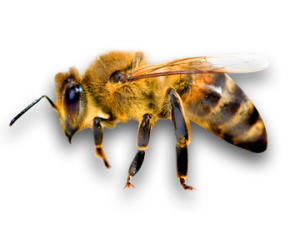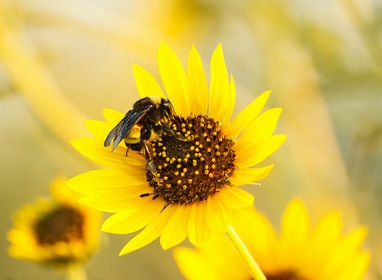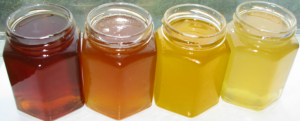Different honey varieties. What’s behind it?
 Why are there different honey varieties? What determines the taste of a particular honey? While out collecting pollen and nectar from various flowers the worker bee will travel around a 3-mile radius from the hive. That’s a lot of work! Each tiny sip comes from whatever plant is flowering at the moment and she decides to land on. The flowers will change throughout the season, giving subtle variation to color, taste, and even viscosity.
Why are there different honey varieties? What determines the taste of a particular honey? While out collecting pollen and nectar from various flowers the worker bee will travel around a 3-mile radius from the hive. That’s a lot of work! Each tiny sip comes from whatever plant is flowering at the moment and she decides to land on. The flowers will change throughout the season, giving subtle variation to color, taste, and even viscosity.
That’s one of the really fun things about our Flagstaff wildflower honey, the different honey varieties and variation in taste is a direct reflection of what’s growing right here in Northern Arizona! Sometimes honey will even vary from one side of Flagstaff to the other. For example, we have a hive 20 minutes west of Flagstaff in a little area called Parks. When we pulled honey from that (very productive) hive this summer the honey was very light in color and in taste. People told us it was their favorite honey ever!
 So what was the secret? Nothing we’ve done. It’s nature, plain and simple. In that particular area, there were huge fields of Prairie Sunflowers growing. Could that have been the main source of the bee’s nectar they were turning into honey? Perhaps. This may have been the dominant nectar source for the Flagstaff wildflower honey that we pulled from this hive. I suspect it was because we also collected some extra honey from a bee removal in Bellemont nearby that was surrounded by these flowers and tasted very similar.
So what was the secret? Nothing we’ve done. It’s nature, plain and simple. In that particular area, there were huge fields of Prairie Sunflowers growing. Could that have been the main source of the bee’s nectar they were turning into honey? Perhaps. This may have been the dominant nectar source for the Flagstaff wildflower honey that we pulled from this hive. I suspect it was because we also collected some extra honey from a bee removal in Bellemont nearby that was surrounded by these flowers and tasted very similar.
When you see different honey varieties there really is a lot to it! Honey that’s labeled “Clover Honey”, “Orange Honey”, “Buckwheat Honey”, or even “Mesquite Honey” means those are the dominant flowers the bees are foraging on. Typically hives are placed in orchards or areas where those flowers are in abundance, so those flowers are what is used by the bees to create honey.
Honey made from these various sources each have different tastes, colors, flow, and even sugar content. Clover honey tends to be somewhat light in color and taste, while some varieties like Buckwheat honey is very dark and thick, with a taste somewhat similar to molasses. It is considered to be the highest in antioxidants and minerals of all honey produced in the US. In contrast, Catclaw honey is VERY light and sweet and tends to be a favorite of tea drinkers as it sweetens without adding too much honey flavor or bitterness.
Like different coffee roasts, various honey lovers have their own favorites. We encourage you to get out there and try it! Visit your local farmers market where you can often sample various honey from the area and find your favorite! Whatever you do, don’t buy the cheap grocery store “honey”. The truth is it’s probably not even real honey and certainly doesn’t taste anywhere near the same!
 Our honey is produced right here in the beautiful Northern Arizona mountains of Flagstaff and we think it’s the bee’s knees! We have easy online ordering and hand-deliver all our honey right to your doorstep. We even have a Hive2Home monthly delivery service to bring you our wildflower honey blend on a regular basis. It’s a popular movement with many people who have tried our honey here in Flagstaff.
Our honey is produced right here in the beautiful Northern Arizona mountains of Flagstaff and we think it’s the bee’s knees! We have easy online ordering and hand-deliver all our honey right to your doorstep. We even have a Hive2Home monthly delivery service to bring you our wildflower honey blend on a regular basis. It’s a popular movement with many people who have tried our honey here in Flagstaff.
Try it. We guarantee you’ll like it!




